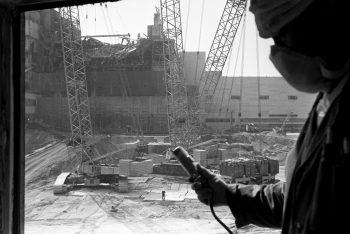Sophie Pinkham at the NYRB:

One of the most alarming—though also eerily beautiful—aspects of Brown’s book is her description of the way radioactive material moves through organisms, ecosystems, and human society. Of the infamous May Day parade held in Kiev just after the explosion, Brown writes:
The newsreels of the May holiday did not record the actions of two and a half million lungs, inhaling and exhaling, working like a giant organic filter. Half of the radioactive substances Kyivans inhaled their bodies retained. Plants and trees in the lovely, tree-lined city scrubbed the air of ionizing radiation. When the leaves fell later that autumn, they needed to be treated as radioactive waste.
Radioactive fallout was distributed far beyond the Exclusion Zone, which was, after all, just a circle on a map. Clouds absorbed radiation and then moved with the wind. Red Army pilots were dispatched to seed clouds with silver iodide so that radioactive rain would fall over provincial Belarus rather than urban Russia. Belarusian villagers fell ill, as did the pilots.
more here.
